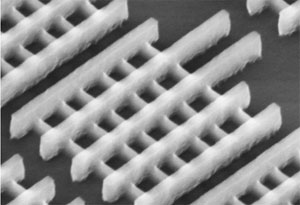 Moving beyond two dimensional circuitry on chips, Intel says it's in the process of creating what it calls “Tri-Gate” technology, or 3-D based transistors that rise up vertically from a wafer’s surface, similar to the way high-rise buildings create more space in cities. The Tri-Gate transistors, which will appear later this year in Intel’s coming “Ivy Bridge” processors, will offer performance that's 37 percent better, using 50 percent less power, than the current 32 nm chip design. That would make Tri-Gate perfect for smartphones and tablets. Intel said it will ship the new chips in PCs and servers by early 2012, but was mum about when it will move them into tablets and smartphones—the only chip market Intel doesn’t currently dominate. Currently, ARM controls that market. It doesn’t seem concerned about Intel’s move. ARM is already at work on testing chips at 20nm and 22nm process nodes, and earlier this year announced a partnership with IBM for work on a 14nm scale chip. Another challenge for Intel: OS developers will most likely wonder if they want to spend time and money developing for the new architecture. Plus, rival AMD points out that Intel can’t break into the mobile device market on CPU horsepower alone, but will need better graphics ability. Still, Intel's the biggest chip maker around and its announcement surely sent competitors scrambling to develop their own 3D chips. Intel says it has a two year head start, so it remains to be seen whether ARM can keep its hold on the mobile market.
Moving beyond two dimensional circuitry on chips, Intel says it's in the process of creating what it calls “Tri-Gate” technology, or 3-D based transistors that rise up vertically from a wafer’s surface, similar to the way high-rise buildings create more space in cities. The Tri-Gate transistors, which will appear later this year in Intel’s coming “Ivy Bridge” processors, will offer performance that's 37 percent better, using 50 percent less power, than the current 32 nm chip design. That would make Tri-Gate perfect for smartphones and tablets. Intel said it will ship the new chips in PCs and servers by early 2012, but was mum about when it will move them into tablets and smartphones—the only chip market Intel doesn’t currently dominate. Currently, ARM controls that market. It doesn’t seem concerned about Intel’s move. ARM is already at work on testing chips at 20nm and 22nm process nodes, and earlier this year announced a partnership with IBM for work on a 14nm scale chip. Another challenge for Intel: OS developers will most likely wonder if they want to spend time and money developing for the new architecture. Plus, rival AMD points out that Intel can’t break into the mobile device market on CPU horsepower alone, but will need better graphics ability. Still, Intel's the biggest chip maker around and its announcement surely sent competitors scrambling to develop their own 3D chips. Intel says it has a two year head start, so it remains to be seen whether ARM can keep its hold on the mobile market. Intel Positions Itself to Power Mobile Devices
When Intel said it's creating a fundamentally new 3D chip design last week, the IT world marveled at the latest innovation. Yet when the initial euphoria of the chip design settles, it is the potential of the new chip for future mobile applications that many are wondering if the “Intel inside” logo will be stamped on smartphones soon.  Moving beyond two dimensional circuitry on chips, Intel says it's in the process of creating what it calls “Tri-Gate” technology, or 3-D based transistors that rise up vertically from a wafer’s surface, similar to the way high-rise buildings create more space in cities. The Tri-Gate transistors, which will appear later this year in Intel’s coming “Ivy Bridge” processors, will offer performance that's 37 percent better, using 50 percent less power, than the current 32 nm chip design. That would make Tri-Gate perfect for smartphones and tablets. Intel said it will ship the new chips in PCs and servers by early 2012, but was mum about when it will move them into tablets and smartphones—the only chip market Intel doesn’t currently dominate. Currently, ARM controls that market. It doesn’t seem concerned about Intel’s move. ARM is already at work on testing chips at 20nm and 22nm process nodes, and earlier this year announced a partnership with IBM for work on a 14nm scale chip. Another challenge for Intel: OS developers will most likely wonder if they want to spend time and money developing for the new architecture. Plus, rival AMD points out that Intel can’t break into the mobile device market on CPU horsepower alone, but will need better graphics ability. Still, Intel's the biggest chip maker around and its announcement surely sent competitors scrambling to develop their own 3D chips. Intel says it has a two year head start, so it remains to be seen whether ARM can keep its hold on the mobile market.
Moving beyond two dimensional circuitry on chips, Intel says it's in the process of creating what it calls “Tri-Gate” technology, or 3-D based transistors that rise up vertically from a wafer’s surface, similar to the way high-rise buildings create more space in cities. The Tri-Gate transistors, which will appear later this year in Intel’s coming “Ivy Bridge” processors, will offer performance that's 37 percent better, using 50 percent less power, than the current 32 nm chip design. That would make Tri-Gate perfect for smartphones and tablets. Intel said it will ship the new chips in PCs and servers by early 2012, but was mum about when it will move them into tablets and smartphones—the only chip market Intel doesn’t currently dominate. Currently, ARM controls that market. It doesn’t seem concerned about Intel’s move. ARM is already at work on testing chips at 20nm and 22nm process nodes, and earlier this year announced a partnership with IBM for work on a 14nm scale chip. Another challenge for Intel: OS developers will most likely wonder if they want to spend time and money developing for the new architecture. Plus, rival AMD points out that Intel can’t break into the mobile device market on CPU horsepower alone, but will need better graphics ability. Still, Intel's the biggest chip maker around and its announcement surely sent competitors scrambling to develop their own 3D chips. Intel says it has a two year head start, so it remains to be seen whether ARM can keep its hold on the mobile market.
 Moving beyond two dimensional circuitry on chips, Intel says it's in the process of creating what it calls “Tri-Gate” technology, or 3-D based transistors that rise up vertically from a wafer’s surface, similar to the way high-rise buildings create more space in cities. The Tri-Gate transistors, which will appear later this year in Intel’s coming “Ivy Bridge” processors, will offer performance that's 37 percent better, using 50 percent less power, than the current 32 nm chip design. That would make Tri-Gate perfect for smartphones and tablets. Intel said it will ship the new chips in PCs and servers by early 2012, but was mum about when it will move them into tablets and smartphones—the only chip market Intel doesn’t currently dominate. Currently, ARM controls that market. It doesn’t seem concerned about Intel’s move. ARM is already at work on testing chips at 20nm and 22nm process nodes, and earlier this year announced a partnership with IBM for work on a 14nm scale chip. Another challenge for Intel: OS developers will most likely wonder if they want to spend time and money developing for the new architecture. Plus, rival AMD points out that Intel can’t break into the mobile device market on CPU horsepower alone, but will need better graphics ability. Still, Intel's the biggest chip maker around and its announcement surely sent competitors scrambling to develop their own 3D chips. Intel says it has a two year head start, so it remains to be seen whether ARM can keep its hold on the mobile market.
Moving beyond two dimensional circuitry on chips, Intel says it's in the process of creating what it calls “Tri-Gate” technology, or 3-D based transistors that rise up vertically from a wafer’s surface, similar to the way high-rise buildings create more space in cities. The Tri-Gate transistors, which will appear later this year in Intel’s coming “Ivy Bridge” processors, will offer performance that's 37 percent better, using 50 percent less power, than the current 32 nm chip design. That would make Tri-Gate perfect for smartphones and tablets. Intel said it will ship the new chips in PCs and servers by early 2012, but was mum about when it will move them into tablets and smartphones—the only chip market Intel doesn’t currently dominate. Currently, ARM controls that market. It doesn’t seem concerned about Intel’s move. ARM is already at work on testing chips at 20nm and 22nm process nodes, and earlier this year announced a partnership with IBM for work on a 14nm scale chip. Another challenge for Intel: OS developers will most likely wonder if they want to spend time and money developing for the new architecture. Plus, rival AMD points out that Intel can’t break into the mobile device market on CPU horsepower alone, but will need better graphics ability. Still, Intel's the biggest chip maker around and its announcement surely sent competitors scrambling to develop their own 3D chips. Intel says it has a two year head start, so it remains to be seen whether ARM can keep its hold on the mobile market. 
